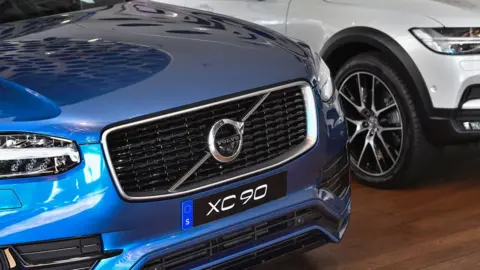Volvo shows electric cars are coming. But how quickly?
 Getty Images
Getty ImagesVolvo's announcement certainly electrified the internet. The Chinese-owned carmaker caused great excitement on Wednesday when it said that every vehicle it launches from 2019 will have an electric motor.
This, it added, marked a "historic end of cars that have only an internal combustion engine".
There is no doubt that the car industry is changing at speed. From electric vehicles, to self-driving technology, to investments in ride-sharing and taxi companies, carmakers are trying to get a toehold in areas that have the potential to upend the automotive sector in the coming years.
But it isn't clear that Volvo's latest move presents a big acceleration in the pace of change.
How electric is electric?
The BBC's Theo Leggett points out that all the car companies are responding to tighter emissions standards that will apply across their fleets from 2021. Introducing electric or partly electric vehicles can only help with that.
Indeed, Volvo already offers a plug-in hybrid option for its top of the range models, like the XC90. Other car companies are heading in the same direction. Jaguar Land Rover last year said it expects up to 50% of its range to be electrified by 2020.
It is also worth asking just how electric we are talking. Volvo said it would introduce a "portfolio of electrified cars across its model range, embracing fully electric cars, plug-in hybrid cars and mild-hybrid cars". That covers a wide range of outcomes.
Mild hybrids are essentially a standard car, typically with a petrol engine. But they have a larger battery which can help at low speeds. The battery is a booster for the engine, improving efficiency. But it only works at low speeds and for short distances - think of it as a helping hand as you pull away from the lights in a built-up, busy area.
One large car company puts the fuel economy benefit for mild hybrids at about 6%, around towns and cities where it is most likely to be used. That is a far cry from the fully electric future espoused by Tesla, and other car companies.
 Getty Images
Getty ImagesFully electric vehicles remain expensive, both for carmakers and for customers. Meanwhile, a range of 250 to 300 miles still provides challenges.
That is one reason the industry is also focused on so-called plug-in hybrids. These have an electric engine that can travel perhaps 50-60 miles, before a traditional petrol or diesel engine takes over. The trouble here, as with standard hybrids, is that the extra weight from the engines makes the car quite inefficient when it reverts to burning fossil fuels.
Money
Ultimately, lift-off for electric vehicles boils down to costs. Most electric vehicles are still loss-making for the carmakers, and more expensive for car buyers. Widespread adoption relies on lower energy and maintenance costs balancing a higher sticker price for the buyer (where the carmaker also makes some profit).
Analysts at UBS recently upped their forecast for sales of electric vehicles, on the basis that this cost parity can be achieved earlier than expected. They see sales really picking up from 2020, forecasting that by 2025 electric vehicle sales could account for 14% of the car market.
Given that emissions standards are only pushing the industry in one direction, carmakers have every incentive to promote electric vehicles (or vehicles with a part electric option). Greater volumes will start to reduce costs.
There is another important factor in terms of how quickly the electric future arrives. Remember Nissan: In last year's discussions with the UK government after the vote to leave the European Union, the Japanese company had a particular set of concerns around further investment in its huge Sunderland plant.
As a "global leader in electric cars" it wanted changes to help the roll-out of charging stations, as well as tax incentives to encourage the purchase of electric vehicles. Those were areas where the government swiftly acted.
As much as anything, the point at which electric vehicles really motor will be determined by governments.
